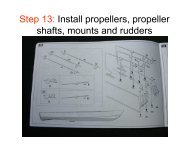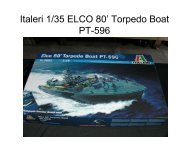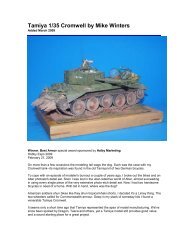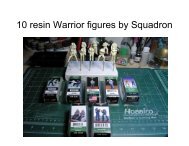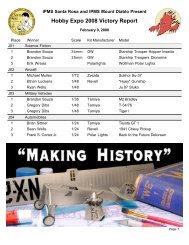Tamiya 1/35 Ford GPA - IPMS Santa Rosa
Tamiya 1/35 Ford GPA - IPMS Santa Rosa
Tamiya 1/35 Ford GPA - IPMS Santa Rosa
- No tags were found...
You also want an ePaper? Increase the reach of your titles
YUMPU automatically turns print PDFs into web optimized ePapers that Google loves.
<strong>Ford</strong> <strong>GPA</strong> by Jack RiggerAdded September 2005The <strong>Tamiya</strong> 1/<strong>35</strong> scale <strong>Ford</strong> "<strong>GPA</strong>" (General Purpose Amphibian) is an old kit from the70's. Even though it is well engineered, it does have a few shortcomings typical of theperiod. Some of the details are crudely integrated into the kit design and need to becorrected or modified.The leaf springs are molded smooth without detail, so I added pieces of stretched sprueglued lengthwise along each spring to simulate the individual leaves. I then added stripstyrene to simulate the bands holding the leaves together. This also hid the huge gaps leftby the axle assemblies.The three molded-in handles on the sides of the hull were ground out with a ball shapedgrinding bit and replaced with strip styrene. The deck is too thick and sits above theedges of the hull. It had to be thinned down to properly sit below flush. Styrene stripbraces were added to the air intake cover. The headlights were also ground out with smallholes drilled inside them to simulate a bulb. They were then wired up using surgicalsuture. A few grab handles at the edges of the deck were made out of left over brass froman old photo etch set. (I just can't throw anything away!)Tire valves were made using stretched sprue. The lug holes were drilled out for the sparetire. A hold-down mechanism was fashioned from strip styrene and a bolt & nut cut offan old wheel from the spares box.All the shift levers (except one) were replaced with stretched sprue. The kit's ball knobswere drilled out to accept the new levers. The instruments were all hand painted, thencovered with a drop of clear gloss to simulate glass. The seat cushions were carved outwith a tiny drum sander on a moto-tool to look as though they have been sat in.
The whole vehicle was airbrushed using Poly Scale US olive drab. After thoroughly dry,it was given a wash with thinned down flat black enamel, the excess wiped clean and leftto dry. Then I dry-brushed with the base color to accent the raised detail. Next, therecessed details were accented again with black chalk pastel applied with a small paintbrush. Then I dry-brushed once more with dust and dirt colored enamels and acrylics inthe proper areas to look used and weathered.Because the decals have a lot of clear areas, the entire model was then shot with a coupleof light coats of Future floor polish and left to dry thoroughly before applying the decals.The decals went on smoothly, but I had to use liberal amounts of Micro Sol to help themlay down. They were then weathered as described above and the entire model was shotwith Testors clear flat.The windscreen was masked off using bare metal foil and painted. Masks were cut frommasking tape with a compass and applied where the wipers would have cleaned thewindscreen, then I lightly dry brushed the clear area with a khaki color.The kit supplied driver was OK and I liked the pose, however the fingers neededseparated and the clothing required some undercut scribing to bring out some relief. Hewas painted using mostly Poly Scale paints and Humbrol flesh. The highlighting andshadowing was done basically the same as the vehicle, with washes, dry brushing, andpastels. I even added a little 5 o'clock shadow with black pastel.This model was a truly enjoyable and satisfying endeavor and I would highly recommendthis kit to any armor enthusiast, beginner to experienced.Album (select a picture to view at full size):Page 1



